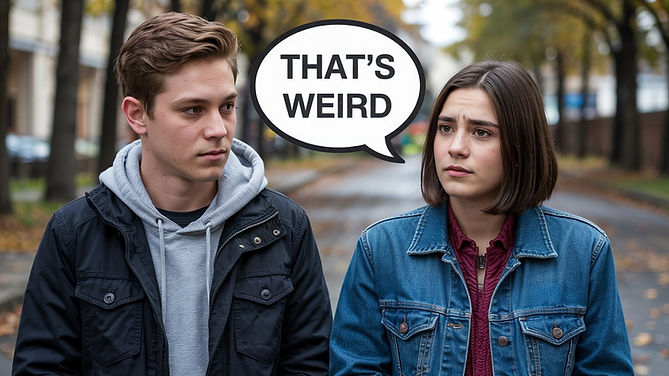AskDwightHow.org 365/24/7
THE 14:24 GUEST HOUSE
14m 24s


We'll get your problem solved one way or the other. Open this door


Sneaky Blame: How Generational Language Reveals Hidden Blame
Disapproval tends to be an endemic part of social interaction. We notice something we dislike, something that rubs us the wrong way or contradicts our values—and we react. But how we express that disapproval, and how directly we assign blame, has evolved across generations. From the polite but pointed remarks of Baby Boomers to the irony-laced sarcasm of Gen Z, our disapproving phrases often double as a subtle—and socially acceptable—way to blame others without being called out for it. By learning to spot these phrases in our own language, we gain a powerful opportunity: the ability to recognize when we're indulging in a view of the world that is populated by the good guys and bad guys, the victims and the villains.
The Boomer Diplomacy: Polite but Seeming with Good Intent
For Baby Boomers, disapproval often comes dressed in civility. Phrases like “That’s inappropriate” or “I’m not comfortable with that” allow speakers to maintain a tone of respect while signaling that a right-wrong boundary has been crossed. Even softer expressions—“Bless their heart” or “Interesting choice”—may seem innocuous, but they carry a quiet judgmental weight. These phrases let Boomers imply blame or distance themselves from the perceived wrongdoer while preserving social harmony. When we use them, we might feel justified—after all, we didn’t say anything rude—but the underlying message is still one of judgment. Catching ourselves saying “That’s questionable” might be a clue that we’re not just observing, but quietly condemning.
Gen X: The Art of Disaffected Disapproval
Generation X, raised in the shadow of cynicism and media saturation, tends to favor indirect but unmistakable signals of scorn. A sarcastic “Good luck with that” or a curt “Whatever” communicates more than just disapproval—it communicates disengagement. It's as if the speaker is saying, "You're not just wrong, you're not even worth my energy." This approach minimizes confrontation while still making clear who the fool—or villain—is in the scenario. If we catch ourselves muttering “Seriously?” or “Not cool”, we might ask: am I making a thoughtful observation, or am I writing someone off in a way that keeps me feeling morally superior?
Millennial Code: Irony, Image, and Avoidance
Millennials often rely on language shaped by the Internet, where disapproval is dressed in humor or image consciousness. Saying something is “cringe”, “sus”, or “not a good look” distances the speaker from the behavior without naming it directly as wrong. These phrases act as social filters—they let the speaker avoid being seen as judgmental while still expressing judgment. If we say “Yikes” or “Hard pass”, we might feel like we’re just voicing a preference, but underneath, we’re drawing moral lines. These cues can help us pause and ask: am I really just expressing a reaction, or am I labeling someone as the bad guy (the villain) in this situation?
Gen Z: The Casual Call-Out
For Gen Z, disapproval often comes through meme-influenced shorthand and performative detachment. Phrases like “This ain’t it”, “Red flag”, or “It’s giving desperate” carry a punch of judgment cloaked in trend-savvy detachment. Saying something is “weird” or giving “side-eye” may seem like minor social commentary, but it creates moral distance: “I’m not like that.” These are signals of social exclusion—ways to mark someone or something as unacceptable without confrontation. When we use these phrases, especially reflexively, it can be a signal that we're falling into the trap of moral sorting: deciding who’s “in” and who’s “out,” often without realizing it.
Why It Matters: Noticing the Blame Game
What unites all these generational expressions is their ability to convey blame while minimizing the chance of being challenged for it. They allow us to protect our self-image as kind, fair, or open-minded people, even while placing others in the moral wrong. But if we want to grow in awareness—and compassion—it helps to become fluent in our own disapproval language. By tuning in to the words we use when we think someone else is “wrong,” we give ourselves the chance to ask deeper questions: Am I viewing this person as a bad-guy villain? Am I seeing the world through a lens of good and bad, right and wrong?
The language of disapproval is a map—one that reveals how we morally position ourselves in the world (either not realizing there is a world outside the HOGAB or not noticing that we wandered back into it). When we spot the clues in our own speech, we gain the power to choose something different: curiosity over condemnation, humility over moral high ground, connection over critique. The words we use matter—not just for how they land with others, but for what they reveal about how we see ourselves.











